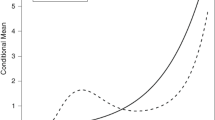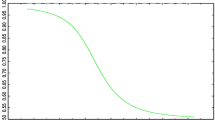Abstract
We consider method-of-moments fixed effects (FE) estimation of technical inefficiency. When dealing with a large number of cross-sectional observations, N, it is possible to obtain consistent moment estimators of the inefficiency distribution. It is well known that the classical FE estimator may be seriously upward biased when N is large and T, the number of time observations, is small. The method-of-moments FE estimators do not suffer from this type of bias in large-N settings. The proposed methodology bridges classical FE and maximum likelihood estimation, leading to a reduction in bias without making the random effects assumption.
Similar content being viewed by others
Notes
The conditional and unconditional averages of these estimators converge in mean to the counterparts of the inefficiency random variable as \(N\rightarrow \infty\).
The letter \(\nu\) without sub-script denotes the population random variable of the random error. Later on in the text, we also use \(\alpha\) and u to denote the corresponding population random variables for the fixed effects and inefficiency.
If \(E|\hat{u}_i-\hat{u}_i^a|\rightarrow 0\), then convergence in mean for the conditional expectations is proved as follows: \(E(|E(\hat{u}_i-\hat{u}_i^a|u_i)|)\le E(E(|(\hat{u}_i-\hat{u}_i^a||u_i))=E(|\hat{u}_i-\hat{u}_i^a|)\rightarrow 0\), where the inequality is given by the triangle inequality and the equality by the law of iterated expectations.
By the Cauchy–Swartz inequality: \(E|\bar{x}_i(\beta -\hat{\beta })|\le ( E(\bar{x}_i)^2) ^{1/2}( E(\beta -\hat{\beta })^2) ^{1/2}\rightarrow 0\) in quadratic mean, since the mean-square error of the least-squares estimator tends to zero as \(N\rightarrow \infty\).
Results for consistency and asymptotic normality are given in the Appendix provided in the supplementary materials of this publication. Several of the results are adopted from Wikström (2015) who consider similar method of moment estimation for the ‘true’ FE model.
Throughout this paper, we use the within estimator of \(\beta\) and within-transformations such as \(\ddot{z}_{it}=z_{it}-\bar{z}_{i}\) (e.g. Wooldridge 2010).
Corresponding to \(\theta\) in the general setting.
References
Amemiya T (1985) Advanced econometrics, 1st edn. Harvard University Press, Cambridge
Erwidodo (1990) Panel data analysis on farm-level efficiency, input demand and output supply of rice farming in West Java, Indonesia. Ph.D. thesis, Michigan State University
Greene W (1980) Maximum likelihood estimation of econometric frontier functions. J Econ 13:27–56
Lovell K (1993) Production frontiers and productive efficiency. In: Fried H, Lovell K, Schmidt S (eds) The measurement of productive efficiency. Oxford University Press, Oxford, pp 3–67
Richmond J (1974) Estimating the efficiency of production. Int Econ Rev 15:515–521
Satchachai P, Schmidt P (2010) Estimates of technical inefficiency in stochastic frontier models with panel data: generalized panel jackknife estimation. J Prod Anal 34:83–97
Schmidt P, Sickles R (1984) Production frontiers and panel data. J Bus Econ Stat 2:367–374
Wang W, Schmidt P (2009) On the distribution of estimated technical efficiency in stochastic frontier models. J Econ 148:36–45
Wikström D (2015) Consistent method of moments estimation of the true fixed effects model. Econ Lett 137:62–69
Wooldridge JM (2010) Econometric analysis of cross section and panel data, 2nd edn. MIT Press, Cambridge
Acknowledgments
We thank an anonymous Associate Editor for very helpful comments.
Author information
Authors and Affiliations
Corresponding author
Electronic supplementary material
Below is the link to the electronic supplementary material.
Rights and permissions
About this article
Cite this article
Wikström, D. Modified fixed effects estimation of technical inefficiency. J Prod Anal 46, 83–86 (2016). https://doi.org/10.1007/s11123-016-0473-3
Published:
Issue Date:
DOI: https://doi.org/10.1007/s11123-016-0473-3




